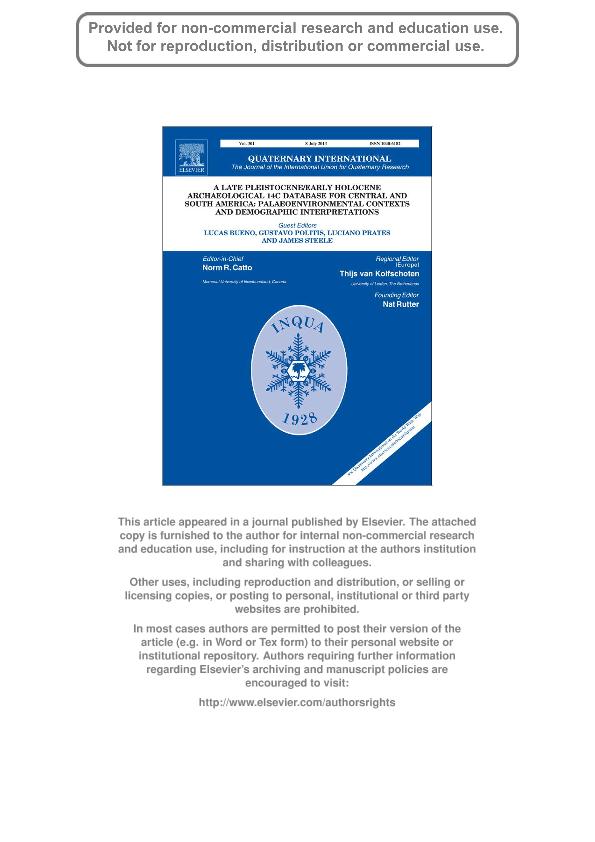Mostrar el registro sencillo del ítem
dc.contributor.author
Charo, Melisa Paola

dc.contributor.author
Gordillo, Sandra

dc.contributor.author
Fucks, E. E.
dc.date.available
2017-03-06T19:46:17Z
dc.date.issued
2013-07
dc.identifier.citation
Charo, Melisa Paola; Gordillo, Sandra; Fucks, E. E.; Paleoecological significance of Late Quaternary molluscan faunas of the Bahia San Blas area, Argentina; Elsevier; Quaternary International; 301; 7-2013; 135-149
dc.identifier.issn
1040-6182
dc.identifier.uri
http://hdl.handle.net/11336/13570
dc.description.abstract
Late Quaternary marine deposits in the area of Bahía San Blas (Buenos Aires, Argentina) form beach ridges and tidal plains bearing remains of organisms, mainly mollusc shells. These mollusc assemblages were characterized, and their changes assessed both over time, and related to local environmental factors. Twenty-six sites were analyzed, eleven Pleistocene, seven Holocene and eight modern sites. Fifty taxa (27 bivalves and 23 gastropods) were recorded for the area, with marine species predominant over estuarine. Within gastropods, epifaunal species and carnivores are predominant, with a lower proportion of herbivores and filter feeders, while bivalves are mostly infaunal and suspension feeders. Pleistocene associations are characterized by the high quantity of molluscs in rocky environments, and those of the Holocene by the presence of the warm water Crassostrea rhizophorae, which is currently displaced to lower latitudes. Within the modern associations four taxa, Mesodesma mactroides, Solen tehuelchus, Barnea lamellosa and Crassostrea gigas (an introduced species), are not recorded as fossils, but Mesodesma mactroides is found in Holocene shell middens from the area. According to multivariate analysis, the sites were divided into two groups: high energy deposits (storm ridges) and low-energy deposits (tidal plains), regardless of their age. Based on these results, mollusc variations in the area are thought to be related in part to changes in temperature that took place since the Pleistocene (e.g. C. rhizophorae); but mostly associated with the presence of sub-environments of different energy levels. This would favor the presence of different taxa in accordance to their ecological requirements.
dc.format
application/pdf
dc.language.iso
eng
dc.publisher
Elsevier

dc.rights
info:eu-repo/semantics/openAccess
dc.rights.uri
https://creativecommons.org/licenses/by-nc-sa/2.5/ar/
dc.subject
Molluscs
dc.subject
Pleistocene
dc.subject
Holocene
dc.subject
Paleoecology
dc.subject.classification
Paleontología

dc.subject.classification
Ciencias de la Tierra y relacionadas con el Medio Ambiente

dc.subject.classification
CIENCIAS NATURALES Y EXACTAS

dc.title
Paleoecological significance of Late Quaternary molluscan faunas of the Bahia San Blas area, Argentina
dc.type
info:eu-repo/semantics/article
dc.type
info:ar-repo/semantics/artículo
dc.type
info:eu-repo/semantics/publishedVersion
dc.date.updated
2017-03-06T14:08:03Z
dc.journal.volume
301
dc.journal.pagination
135-149
dc.journal.pais
Países Bajos

dc.journal.ciudad
Amsterdam
dc.description.fil
Fil: Charo, Melisa Paola. Universidad Nacional de La Plata. Facultad de Ciencias Naturales y Museo; Argentina. Consejo Nacional de Investigaciones Científicas y Técnicas; Argentina
dc.description.fil
Fil: Gordillo, Sandra. Consejo Nacional de Investigaciones Científicas y Técnicas. Centro Científico Tecnológico Córdoba. Centro de Investigaciones en Ciencias de la Tierra; Argentina. Universidad Nacional de Córdoba; Argentina
dc.description.fil
Fil: Fucks, E. E.. Universidad Nacional de La Plata; Argentina
dc.journal.title
Quaternary International

dc.relation.alternativeid
info:eu-repo/semantics/altIdentifier/doi/http://dx.doi.org/10.1016/j.quaint.2012.12.019
dc.relation.alternativeid
info:eu-repo/semantics/altIdentifier/url/http://www.sciencedirect.com/science/article/pii/S1040618212033861
Archivos asociados
